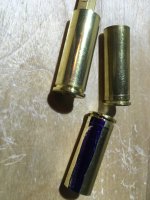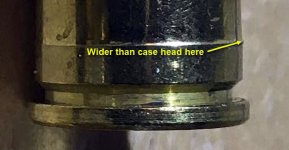I arrived here via a web search for better documentation/instructions for my recently purchased Redding 45 Colt/454 Redding Titanium Carbide die. My die came with the standard generic rifle and handgun die set instructions, nothing specific for the carbide set. My issue was roll/bulging at the bottom of the cases. My web search landed me on this forum; a post dated 7 December 2002 in a conversation between several members who have not posted here in some time or changed their screen name. The specific line entry that I keyed on was:
“I have a Redding Titanium Carbide Sizing Die. The instructions note as follows:”
””Carbide pistol sizing dies are not designed to full length size cases. Adjust the die to size only that portion of the case that has been expanded during firing. In some cases an undersirable ring or belt may appear near the base if the sizing die is incorrectly adjusted. This may weaken the case and is not desirable.””
The description noted in the reported/quoted instructions are exactly what I experienced and thus what brought me here. I am hoping someone might have a copy of those instructions. I have been unsuccessful in locating a copy with the carbide specific wording and Redding via phone sent an electric copy with the standard wording with no mention of the carbide/pistol/roll issue. I have no doubt the quoted document existed, I just want a copy.
Thanking you in advance for the assistance. Yep, I’m new, read the rules, understand the drill. Thanks to the web folks for assisting me with issues created because my typing is almost as bad as my shooting....probably because I’m using the same finger. Keep smiling.
“I have a Redding Titanium Carbide Sizing Die. The instructions note as follows:”
””Carbide pistol sizing dies are not designed to full length size cases. Adjust the die to size only that portion of the case that has been expanded during firing. In some cases an undersirable ring or belt may appear near the base if the sizing die is incorrectly adjusted. This may weaken the case and is not desirable.””
The description noted in the reported/quoted instructions are exactly what I experienced and thus what brought me here. I am hoping someone might have a copy of those instructions. I have been unsuccessful in locating a copy with the carbide specific wording and Redding via phone sent an electric copy with the standard wording with no mention of the carbide/pistol/roll issue. I have no doubt the quoted document existed, I just want a copy.
Thanking you in advance for the assistance. Yep, I’m new, read the rules, understand the drill. Thanks to the web folks for assisting me with issues created because my typing is almost as bad as my shooting....probably because I’m using the same finger. Keep smiling.


